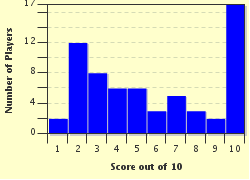Quiz Answer Key and Fun Facts
1. We begin our trip from the Spring Hill Cemetery at Huntington, in what is today West Virginia. Here is buried a general whose home, often called "Green Bottom", is today a museum run by the West Virginia Division of Culture and History and is listed in the National Register of Historic Places. What was the general's name?
2. Our next destination is Fredericksburg, the site of the battle of the same name that was fought on December 13, 1862. There is also a Confederate Cemetery. Here is buried the general who said on the day of his death "I shall come out of this fight a live major general or a dead brigadier". Who was he?
3. After departing Fredericksburg, we go to North Carolina, to the city of Lincolnton. In the city's cemetery rests a Confederate general whose division was the first to interrupt the Army of the Potomac's march for Petersburg. Who was this general?
4. We decide to go back in Virginia, to the Hollywood Cemetery, to visit the grave of one of the youngest brigadiers that served the Southern cause, one who is known as the "Roll Tide" general and was killed at the Battle of Globe Tavern on August 21, 1864. Who was he?
5. We have turned on the radio in our car and are hearing a song by the bluegrass band "The Dixie Bee-Liners" about the Confederate general whose grave we are going to visit in the Cemetery of Glade Spring, Virginia. He had a reputation of being easily annoyed and was given a fitting nickname. Who was this general?
6. Let's leave Virginia for good (as far as this journey is concerned). This time we head for Milledgeville, Georgia. In the Memory Hill Cemetery in this city is buried a Confederate brigadier and businessman. When that man was sixteen years old, he tried to embark secretly with the United States Army to Mexico by the means of sneaking into a stagecoach, but his father found him before it departed. Who was that general?
7. After our visit to Milledgeville, we cross the Mississippi and go to Louisiana. In the city of New Orleans, in Christ Church (Episcopal) Cathedral rests a Confederate General, about whom Sam Watkins, author of "Company Aytch" said: "Second to Stonewall Jackson, his loss was the greatest the South ever sustained". Who was this general, often referred to as a transfer to the CSA Army from the Army of the Lord?
8. We recross the Old Man River and land in the State of Mississippi. We are going towards the Odd Fellows Cemetery in the Monroe County. Here is buried a Confederate General who helped prepare the Ordinance of Secession of Texas and has a county in the aforementioned state named after him. What's his name?
9. We head north to the state of Arkansas. In the city of Helena, at the Maple Hill Cemetery, is the grave of an Irish-born Confederate leader, who is known as "Stonewall of the West". He is also the hero of a graphic novel whose title is his surname. Who was he?
10. Our last destination is the city of Lexington, Kentucky. In the city's cemetery is buried one of the most accomplished Confederate cavalry oficers, a daring and courageous partisan officers whose command was the organized body of Confederates to reach further north. Moreover, his nephew was an evolutionary biologist who won a Nobel Prize in 1933. Who was this general?
Source: Author
DeepHistory
This quiz was reviewed by FunTrivia editor
bloomsby before going online.
Any errors found in FunTrivia content are routinely corrected through our feedback system.

